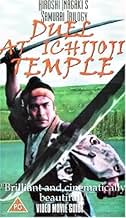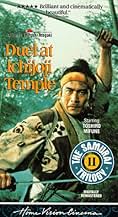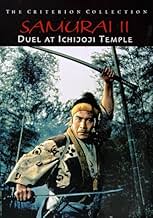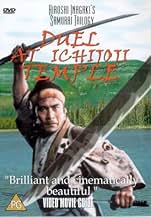VALUTAZIONE IMDb
7,3/10
7324
LA TUA VALUTAZIONE
Aggiungi una trama nella tua linguaMusashi Miyamoto returns to Kyoto after years of absence. After a series of fights against the Yoshioka School, he challenges its master to a duel.Musashi Miyamoto returns to Kyoto after years of absence. After a series of fights against the Yoshioka School, he challenges its master to a duel.Musashi Miyamoto returns to Kyoto after years of absence. After a series of fights against the Yoshioka School, he challenges its master to a duel.
- Regia
- Sceneggiatura
- Star
Recensioni in evidenza
"Miyamoto Musashi" was already a great movie but this movie is even a better one on basically every front.
This movie is part of a real trilogy, that follows one story and one main character. It's therefore also best to watch these 3 movies in a row, to appreciate it best. All 3 movies closely follow each other, in which the first movie is being really used as a movie to set up things, while this second movie is mostly being used to build up to its climax that will occur in the third movie.
This time the movie flows better because the story gets used better as well. Like mentioned earlier, the first movie was still being mostly a setup movie for the series. In this movie we actually get to see more epic moments and fights, as it follows the further travels of Musashi Miyamoto, on his way to become a master-swordsman. Its story and different characters all work out nicely, as things also gets developed more, with its drama and romance.
There are a couple of really great fight sequences, of course mostly featuring Toshirô Mifune. It makes the movie often exciting to watch, as does the overall look for the movie. The movie benefits from its beautiful natural environments, as well as some nicely done studio work. Using color wasn't quite that common yet for '50's Japanese cinema, since it was quite costly and not as advanced yet as in the western world. However color had always worked out nicely for these three movies and it helps to make the movie a really great looking one. You also have to give credit for this to the movie its cinematography, done by Jun Yasumoto, who strangely enough worked on just the first two movies but didn't shot the third and final one.
A movie that really has everything in it.
9/10
http://bobafett1138.blogspot.com/
This movie is part of a real trilogy, that follows one story and one main character. It's therefore also best to watch these 3 movies in a row, to appreciate it best. All 3 movies closely follow each other, in which the first movie is being really used as a movie to set up things, while this second movie is mostly being used to build up to its climax that will occur in the third movie.
This time the movie flows better because the story gets used better as well. Like mentioned earlier, the first movie was still being mostly a setup movie for the series. In this movie we actually get to see more epic moments and fights, as it follows the further travels of Musashi Miyamoto, on his way to become a master-swordsman. Its story and different characters all work out nicely, as things also gets developed more, with its drama and romance.
There are a couple of really great fight sequences, of course mostly featuring Toshirô Mifune. It makes the movie often exciting to watch, as does the overall look for the movie. The movie benefits from its beautiful natural environments, as well as some nicely done studio work. Using color wasn't quite that common yet for '50's Japanese cinema, since it was quite costly and not as advanced yet as in the western world. However color had always worked out nicely for these three movies and it helps to make the movie a really great looking one. You also have to give credit for this to the movie its cinematography, done by Jun Yasumoto, who strangely enough worked on just the first two movies but didn't shot the third and final one.
A movie that really has everything in it.
9/10
http://bobafett1138.blogspot.com/
The great cast that was in Musashi Miyamoto, the first part of this samurai trilogy continues in the second part with a few additions.
By this time Musashi Miyamoto has been on the road for three years and is still learning. The most important lesson as a Samurai will not be learned until the film is almost over. Another important lesson comes quickly after that, and it will interesting to see how it plays out in the final part.
In the opening Musashi Miyamoto is doing battle with a samurai similar to our buddy Hanzo. They are the only two I have ever seen use chains.
After this he heads to Kyoto to do battle with the best in the capital, and also to get himself mixed up with the two women who are in love with him.
Love, fickleness, treachery, rape, revenge, honor, and great sword fighting all have a place in this magnificent film.
The amazing cinematography and scenery also place an important part.
This is truly a samurai classic.
By this time Musashi Miyamoto has been on the road for three years and is still learning. The most important lesson as a Samurai will not be learned until the film is almost over. Another important lesson comes quickly after that, and it will interesting to see how it plays out in the final part.
In the opening Musashi Miyamoto is doing battle with a samurai similar to our buddy Hanzo. They are the only two I have ever seen use chains.
After this he heads to Kyoto to do battle with the best in the capital, and also to get himself mixed up with the two women who are in love with him.
Love, fickleness, treachery, rape, revenge, honor, and great sword fighting all have a place in this magnificent film.
The amazing cinematography and scenery also place an important part.
This is truly a samurai classic.
I've watched the entire trilogy of the Musashi Miyamoto films, of which this film is the second part. The first film, titled simply "Musashi Miyamoto," introduces us to the characters of this and the third film. Without having seen the first film and developing some interest in the welfare of the characters, I certainly wouldn't have sat through the second and third films.
"Duel at Ichijoji Temple," this film, deals with Musashi's exploits as a sort of samurai knight-errant, seeking glory in a very ambiguous and roundabout way. Two women are trailing after him, as Kurosawa films would say, "like goldfish dung." Musashi himself is a flat character on whom Toshiro Mifune's acting skills are wasted. He displays very little emotion or intellect, despite his supposed interest in one of the women and enlightening education by his monk teacher (as we saw in the first film).
If Musashi is flat, the female characters are steamrolled. Their hand wringing, collapsing, and sobbing is typical of American movies of this time period and grows tedious in a samurai film. Having seen other films from this time period set in the days of samurai, I've seen that much more can be done with female characters. The plot was likewise predictable and slow-moving.
If you don't care about characters or plot, the high points of the movie may compensate: beautiful color landscapes and Toshiro Mifune's thrilling fight scenes. Otherwise, I recommend films by Kurosawa or Mizoguchi ("Sanjuro," the mysterious "Ugetsu") over this trilogy. 5/10
"Duel at Ichijoji Temple," this film, deals with Musashi's exploits as a sort of samurai knight-errant, seeking glory in a very ambiguous and roundabout way. Two women are trailing after him, as Kurosawa films would say, "like goldfish dung." Musashi himself is a flat character on whom Toshiro Mifune's acting skills are wasted. He displays very little emotion or intellect, despite his supposed interest in one of the women and enlightening education by his monk teacher (as we saw in the first film).
If Musashi is flat, the female characters are steamrolled. Their hand wringing, collapsing, and sobbing is typical of American movies of this time period and grows tedious in a samurai film. Having seen other films from this time period set in the days of samurai, I've seen that much more can be done with female characters. The plot was likewise predictable and slow-moving.
If you don't care about characters or plot, the high points of the movie may compensate: beautiful color landscapes and Toshiro Mifune's thrilling fight scenes. Otherwise, I recommend films by Kurosawa or Mizoguchi ("Sanjuro," the mysterious "Ugetsu") over this trilogy. 5/10
This comment about the "Samurai Trilogy" starts on the page for Miyamoto Musashi (Samurai I). My first viewing of the second episode was memorable because I got to take the train into town all by myself, and view it in a Tokyo theater. The first episode had just been shown on base, in a sort of cultural exchange, and my parents saw it and were pleasantly non-outraged-- I was a 9-year-old samurai-movie addict, and they believed enthusiasm beyond a certain intensity should be curbed. It was the same conflict as comic books some few years earlier. Technicolor was a big deal back then, especially in Japan, and it became the issue on which my viewing of "swordfighting movies" was decided-- the ones in color were historical films worth viewing, and even had something to teach. The black-and-white ones shown in Irumagawa and surrounding villages-- I had to sneak off to see. Ichijoji no Ketto (Duel at Ichijoji Temple) shows Miyamoto-san's achievements, while barring no holds on the issue of what they cost him. The romantic subplot continues, though its development in the western sense (toward union, wedded bliss) is thwarted at every turn. The issue is always a conflict between love and duty, and each deferment of gratification spells out a new step in the redefinition of the national character that is being mapped here. Again, some of the importance of all this is lost, even to modern Japanese audiences for whom the issues are long settled-- at the time, though, they were cliffhangers. A new character is introduced, Kojiro Sasaki who will emerge in part 3 as a rival for Musashi-- his equal except for certain features in their respective character. By the way, the score is excellent and haunting-- it extends like a symphony through all three parts, and has a leitmotif "hook" that will cause your ears to pick up in recognition, perhaps years from now, when you hear it again.
The follow-up to 1954's excellent Musashi Miyamoto, Duel at Ichijoji Temple picks up the story several years later, as an exiled orphan-turned-swordsman gains notoriety via a bloody tour of fatal duels. His reputation precedes him in returning to his hometown, where old rivals of both a violent and intimate nature await. This is a film about personal growth - specifically that of the samurai himself, who struggles to learn the key concepts of what his new life actually entails and where the rift lies between honor and reverence. We're never quite sure if Musashi takes this lesson to heart, particularly since he's so keen to maintain an impenetrable outer facade in almost every situation. It's a tricky role for period veteran Toshiro Mifune, who struggles with the more nuanced, flatter aspects of the character. In the previous episode, with the fires of young-adulthood to toy with, he excelled. Here, faced with the malaise of mid-life and the accompanying questions of his own being, his performance is far less sublime. The plot, cramped with too many faces and several seemingly-pointless subplots, does him no favors in dancing around the issues and repeating itself on more than one occasion. This could have been an excellent one-act show, and the final half-hour could still stand alone as precisely that. It lacks the gumption of its predecessor, however, and too often cuts away just as the action is getting good.
Lo sapevi?
- QuizMusashi Miyamoto (Toshiro Mifune) is seen carrying two swords. This was a samurai custom known as daisho. Translated this means 'big-little'. The bigger of the two blades was the curved katana, which was generally used for combat and duelling. The short sword was the wakizashi, this blade was generally associated with committing seppuku, however, as can be seen in the film was also used for combat.
- BlooperMany of the guys killed in swordplay go down with either no visible contact between their bodies and a katana, or appear to be hit in the arm or leg with a non-fatal slash that stills ends them, regardless.
- Citazioni
Musashi Miyamoto (Takezo): I renounce my love of women.
- ConnessioniFeatured in Miyamoto Musashi kanketsu-hen: Kettô Ganryû-jima (1956)
I più visti
Accedi per valutare e creare un elenco di titoli salvati per ottenere consigli personalizzati
- How long is Samurai II: Duel at Ichijoji Temple?Powered by Alexa
Dettagli
- Data di uscita
- Paese di origine
- Lingua
- Celebre anche come
- Samurai II: Duel at Ichijoji Temple
- Luoghi delle riprese
- Azienda produttrice
- Vedi altri crediti dell’azienda su IMDbPro
- Tempo di esecuzione
- 1h 44min(104 min)
- Mix di suoni
- Proporzioni
- 1.37 : 1
Contribuisci a questa pagina
Suggerisci una modifica o aggiungi i contenuti mancanti
































